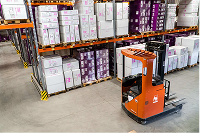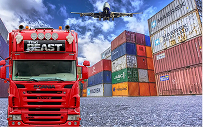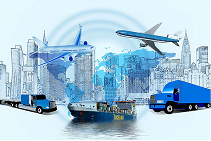E-commerce Supply Chain Management: A Complete Guide
Online shoppers spent US$4.9 trillion in 2021, complicating e-commerce supply chains. Learn how to simplify yours for improved customer experiences.

Fulfilling e-commerce orders is like playing a restaurant management game.
In the game, you’ll take diners’ orders, whip up dishes and serve your customers. Yet, as your restaurant becomes popular and busier, the kitchen gets hectic.
Customers place orders faster than you can cook or serve. When you have too many angry customers with empty stomachs, you lose the game.
This is what happens when you lack a systematic approach to handling online orders.
Similar to playing a restaurant management game, e-commerce order fulfillment requires a sound strategy. Except it’s not a game. It’s real business.
In this e-commerce fulfillment guide, we’ll explain what order fulfillment is.
We’ll also give you actionable tips for optimizing your e-commerce fulfillment process and boosting your customer satisfaction by 10X. Let’s get started!
e-Commerce order fulfillment is the process of handling online orders and delivering goods to customers.
More specifically, it involves storing and managing inventory, picking and packing goods as well as product shipping.
You can think of e-commerce order fulfillment as the journey of goods from when they enter your warehouse to the time they arrive in your customer’s hands.
That’s a simplified view of how e-commerce fulfillment works.
In practice, there are many things to be aware of in the order fulfillment process. Let’s hop into the rabbit hole and see how it works.

The order fulfillment process begins when you receive inventory from your supplier. Typically, the supplier is a manufacturer or wholesaler.
Depending on how you fulfil orders (in-house or outsourced), the goods enter your warehouse or the storage place of your fulfillment services provider.
The next step is inventory storage, which is sometimes known as warehousing.
Despite the label of “inventory storage”, this stage involves much more than simply storing inventory. It also includes managing your inventory in an organized manner.
For example, each unique product (or SKU) should be kept at a separate dedicated storage location.
You can also employ e-commerce inventory management techniques to gain visibility into what’s available in your warehouse (and what’s not), so that you’ll know when to stock up.
Learn more: E-commerce Inventory Management: A Step-By-Step Guide
When you receive orders from customers, goods will be picked from their storage location and prepared for shipment.
This step is sometimes called warehouse order picking.
After goods are retrieved from their respective storage places, they must be packed before being shipped.
There are a few points to note about the process of packing goods.
A packing slip is a document which lists the items to be included in the package.
It contains information such as product SKU, quantity, weight, dimensions, shipping information as well as special notes on the order.
Here is what a packing slip looks like:

There are various benefits with using a packing slip.
For example, it helps the packing team confirm that the right items are included in each package. Customers can also verify items in their order upon receiving the package.
Packaging for e-commerce is important for protecting goods from damage during shipment.
Common packaging materials include corrugated boxes, padded envelopes, bubble wrap and air pillows, but to name a few.
E-commerce packaging is also pivotal to creating positive customer experiences. After all, it is the first physical touchpoint that customers have with your brand.
Learn more: E-commerce Packaging: Mastering The Unboxing Experience in 5 Minutes
Last but not least, a shipping label should be attached to the exterior of your package.
It’ll give the courier the necessary information to deliver the package to the right place.
A shipping label usually includes the recipient’s name, address and a tracking number, such as the following:

Once the package is ready, it can be shipped to your customers.
While e-commerce companies of larger scale may have their own fleet, smaller businesses usually entrust the delivery process to third-party carriers, such as UPS, FedEx or SF Express.
Pro tip: Upon dispatch of goods, let your customers know and give them a tracking number from the carrier (if any). Online shoppers like to stay informed about the delivery status of their parcels.
The order fulfillment process doesn’t end right after packages leave the warehouse. You must be prepared to handle return requests from customers.
As a matter of fact, a quarter of customers return 5% to 15% of what they buy online, according to a survey on consumers’ product return behavior.
In this last step of e-commerce fulfillment, customers will ship the goods back to you or your fulfillment services provider.
You can then restock the items as available inventory (if they are new and fit for resale), or throw away defective products.
Optimizing the order fulfilment process may not help you make a fortune overnight, but it’s crucial for the long-term success of your e-commerce business.
This is because customer experience matters. A lot.
Customer satisfaction often comes hand in hand with having online orders handled promptly and accurately.
Happy customers are likely to become repeat purchasers. They may even become informal brand ambassadors and spread the good word about your company.
All these point to a single outcome — more sales for your online business.
Broadly speaking, there are three ways to fulfil e-commerce orders. They are (1) in-house fulfillment, (2) third-party fulfillment and (3) dropshipping.
In this section, we’ll delve into how each of these e-commerce fulfillment methods work. We’ll also talk about their pros and cons to help you determine which method works best for you.
In-house order fulfilment is also known as self-fulfilment or direct fulfilment.
As its name suggests, fulfilling orders in-house means that the entire fulfilment process is done under your roof.
Using the self-fulfillment model, you’ll receive and store inventory at your own storage place. You’ll also pick and pack goods with your staff.
Third-party fulfillment involves outsourcing the e-commerce fulfillment process to a fulfillment services provider.
These services are commonly offered by third-party logistics (3PL or TPL) companies.
To illustrate this, Boxful Fulfillment’s suite of services covers the essentials for e-commerce businesses.
Everything from storage, fulfillment to return processing is handled by their logistics specialists.
With the help of a 3PL provider, fulfilling e-commerce orders has never been easier!
If you’re looking for funding to grow your e-commerce business, Choco Up is here to help. We’ve worked with hundreds of businesses, providing flexible funding ranging from US$10,000 to $10,000,000 to help companies of all sizes accelerate their growth. Check out what’s in it for you or get a preliminary offer here! (The offer is free, btw.)
Dropshipping is an order fulfilment method which doesn’t require the seller to keep its goods in stock. Rather, goods are stored by the manufacturer.
When an e-commerce seller receives an order from a customer, the order information is manually or automatically forwarded to the manufacturer.
The manufacturer then ships the goods directly to the customer.
Without centralized storage (from which you can dispatch all goods in one go), you’ll have to pay for all three separate shipments. The customer will receive the goods in three different parcels at different times too.
That’s not so great for the customer experience.
The in-house vs. outsource debate has arguments in favor of both sides. Self-fulfillment and working with a 3PL provider have their respective pros and cons.
While there is no absolute answer to which side you should choose, below are some parameters to help you decide.
For those who are new to e-commerce, order fulfillment could be a real pain in the neck.
There are so many aspects to take care of — warehousing, packaging and shipping. Each of these require considerable expertise and knowledge.
Below are some decisions to be made for your e-commerce businesses:
These are just some questions you have to tackle when you fulfil orders in-house.
If you’re confident that your staff can handle all these, then you’re safe with the option of in-house fulfilment. If not, 3PL may be a better choice.
As you make the decision to outsource (or not) your online business’s fulfillment process, order volume is another factor to consider.
In-house fulfillment makes sense if your business is still in its early stage and order volume is relatively low.
However, you may want to go for 3PL services as your company scales. It’s best for customers, who benefit from prompt and reliable fulfillment, and for you (it saves labor and time costs).
Some e-commerce platforms have in-built functions to help you manage inventory and facilitate the shipping process.
Shopify, for example, tracks your inventory and notifies you when you’re running out of stock. It also has shipping integration that works with various carriers (e.g. DHL and UPS).
Merchants with a Shopify store can hence enjoy pre-negotiated shipping rates, and quickly print shipping labels in a few clicks.
Don’t get us wrong. We’re not trying to promote Shopify or belittle other e-commerce platforms.
But those functions of an e-commerce platform would really help ease the workload of your staff, so that self-fulfillment puts less of a burden on your business operations.
Choco Up’s fintech platform does work with Shopify though. It means you can easily and securely connect your Shopify account to apply for funding at Choco Up. We also support WooCommerce, Magento, and other major e-commerce platforms. Click here to see how Choco Up’s funding can help you grow your e-commerce business!
3PL exists to help streamline your order fulfilment process. It shouldn’t be used if it cannot address your business needs.
Below are some examples of services that 3PL providers may not be able to offer:
But outsourcing the order fulfillment process would be beneficial if you need the following:
In the increasingly competitive e-commerce landscape, effective order fulfillment is a secret ingredient in the recipe for online success.
It translates into operational efficiency, as well as satisfied customers and more sales.
But if you have bigger goals for your e-commerce business, namely scaling and growing your company, then we’d add another must-have ingredient to that recipe — funding.
Choco Up’s funding unlocks numerous opportunities for e-commerce businesses.
With our e-commerce funding, companies have boosted revenue growth, expanded product lines and explored new markets, you name it.
To learn more about how we help businesses grow, check out our success stories or apply for funding today!
Grow your business with Choco Up

Online shoppers spent US$4.9 trillion in 2021, complicating e-commerce supply chains. Learn how to simplify yours for improved customer experiences.

While there’s no surefire formula to acing the e-commerce logistics race, we’ve found some proven strategies that work.